A remarkable hoard of thirty-five Ambiani Gallic War Uniface staters (dating c.60-50 BC) with flint container was recently discovered on the Joan Allen ‘Heart of Kent’ Rally at Lenham in Kent. Finder Tony Asquith gives his account of his ‘find of a lifetime’ before Joan Allen team archaeologist Tom Lucking discusses the significance and wider context of the find.
‘Find of a Lifetime’
Tony Asquith
So, all excited, I was up at dawn for the drive down to Lenham, Kent, to attend the Joan Allen ‘Heart of Kent’ Rally, over the weekend of the 26th – 29th August 2022.
It came as no surprise that my first signal on the Friday morning was just a short piece of string with some wire at each end, the second was a shotgun percussion cap, and third was a bit of ‘can slaw’. I thought ‘well, I’ve got all weekend, something good will turn up’, feeling ever the optimist.
Then I got my fourth signal, only about 40 feet into the tractor track. My Minelab Equinox 800 gave a lovely clear signal at 17-18. I bent down to see a disc on the surface and picked it up.
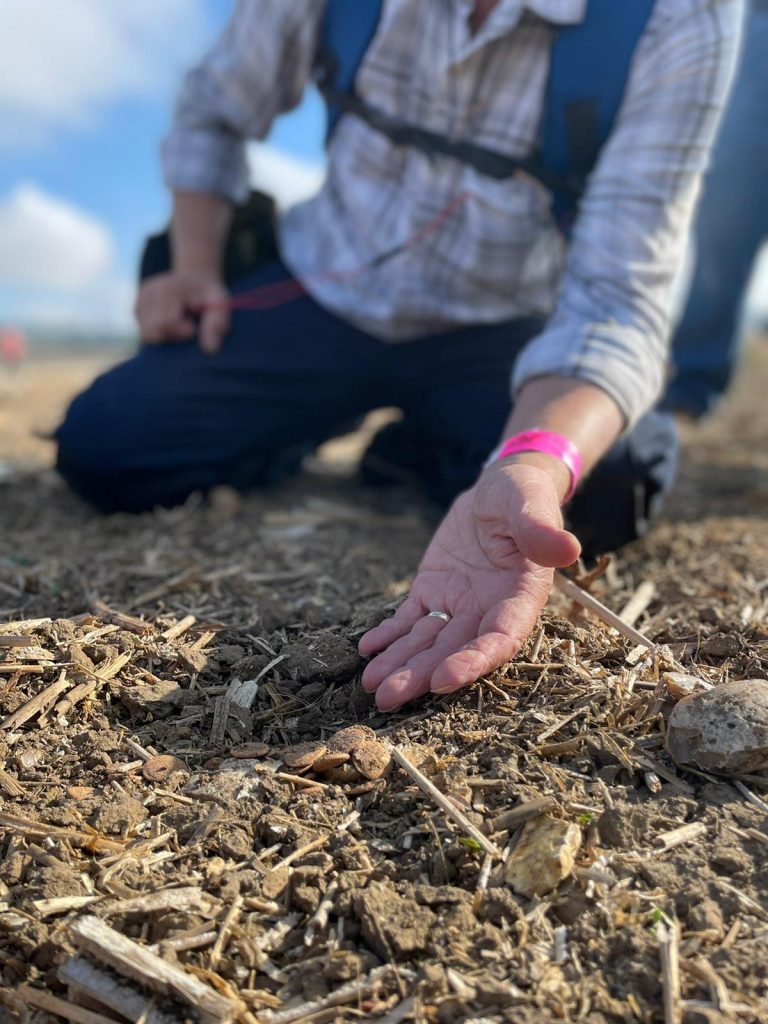
I’m sure you can imagine the unprintable words that I uttered as I saw that the small coin in my hand had the figure of a disjointed horse and other symbols on it, dirty brownish in colour. I knew straight away, in over 40 years of detecting (on and off), I had found my first gold coin and a Celtic stater at that!
Looking down at the ground, I could make out what looked like chocolate buttons, all laid together. This seemed very odd, so I put on my glasses and looked again. I was looking at a pile of dirty, brownish, Celtic staters! What I said is unprintable here, but suffice to say, it was bloody amazing! I then returned the single coin to the hoard, from where I had picked it up.
Once the Joan Allen team, including archaeologist Tom Lucking, had helped cordon off the area, we were able to assess the hoard and collect the coins and flint geode that they had been stored in. It was incredible that we had also found the container for the coins.

This was an amazing experience for me, and I wish to thank all the Joan Allen team and those involved for their prompt and expert help with the recovery. It made it a wonderful experience that I will never forget.
The Lenham Hoard is now going through the Treasure process. This can take a few years, but hopefully a museum will want to show the hoard so that everyone can enjoy the magic of it.
'The Lenham Stater Hoard in Context'
Tom Lucking
The sight of a pile of gold staters lying on the surface of a field was a surreal experience, and one that seemed hard to believe at first! A quick inspection of the coins confirmed they were genuine, and questions were immediately raised about where these coins had come from as they can only have been recently disturbed. As Tony carefully picked out the coins, the final coin was found embedded onto the inside of a fragment of a freshly broken flint nodule. Careful searching and recovery of the rest of the fragments allowed the flint to be pieced back together and revealed the coins to have been deliberately stashed into a hollow spherical flint with a natural opening in one side.
It appeared that this flint ball had probably been rolling around in the ploughsoil for a long time and just happened to be on the surface when the field was cultivated shortly before the rally. The cultivator had struck the flint, smashed it open and left a pile of coins and broken flint ball lying on the surface waiting to be found! Had the field not been searched this year, the coins would almost certainly have been dispersed by further ploughing and the flint container would never have been recovered, even if the coins were eventually found through metal detecting.
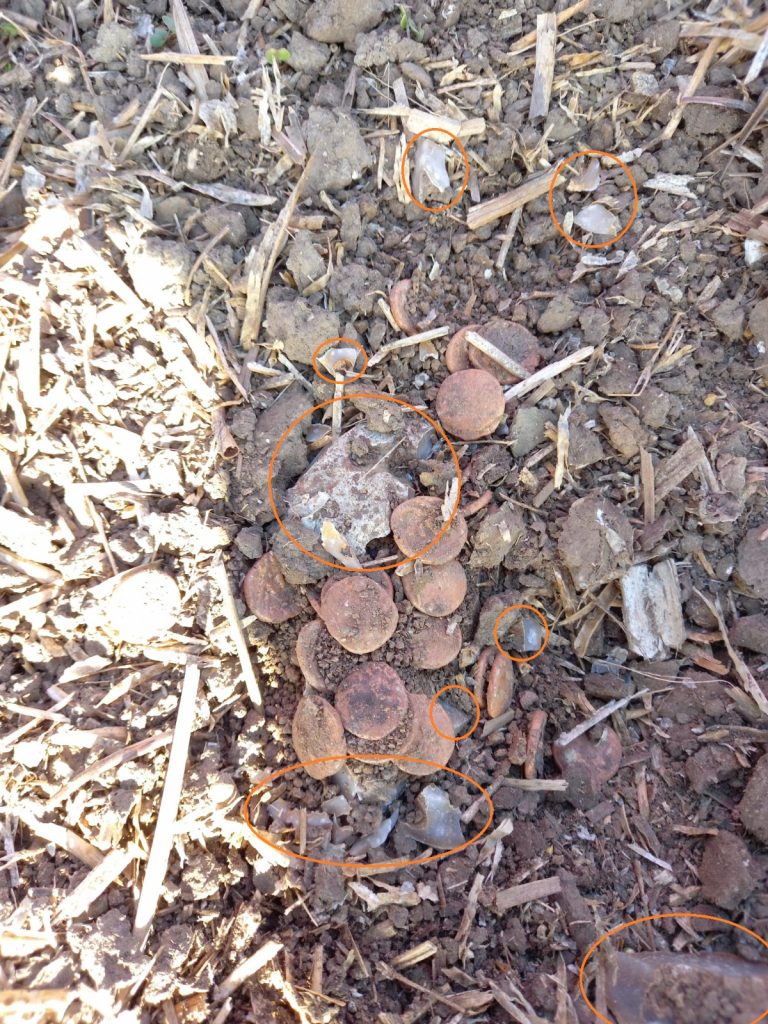
All of the staters within the hoard were Ambiani Gallic War Uniface types (ABC 16), with an obverse showing a horse facing right, dating c.60-50 BC. These are often considered to be war payments made to soldiers fighting against Roman forces in the Gallic Wars at this time, and hoards of this type found in Britain perhaps represent payments given to returning British warriors.
The use of a naturally hollow flint as a vessel for hoarding coins is an unusual, but not unknown, practice in Late Iron Age Britain. De Jersey (2014, 9) records ten other instances, while similar hoards are known from north-western France (Blanchet 1950). Most of these hoards have been found in areas where flint occurs naturally, and it has been suggested that these hollow flint nodules were simply a useful method of concealment in a landscape where these containers were naturally available (Bland et al. 2020). Two similar hoards are known from Kent, one from Higham (Brooke 1923) and a second from Westerham (Brooke 1927). The Lenham Stater Hoard represents the third of this type recorded from the county, and is also the largest at thirty-five coins, while the Higham and Westerham hoards contained eleven and fourteen respectively.
The presence of a spring in the vicinity of the find raises questions about whether this hoard was concealed to hide an individual’s portable wealth, or whether there may have been a more religious or symbolic aspect to this practice and comparison of the three Kentish hoards may suggest a possible preference for the type of landscape into which these hoards were placed.
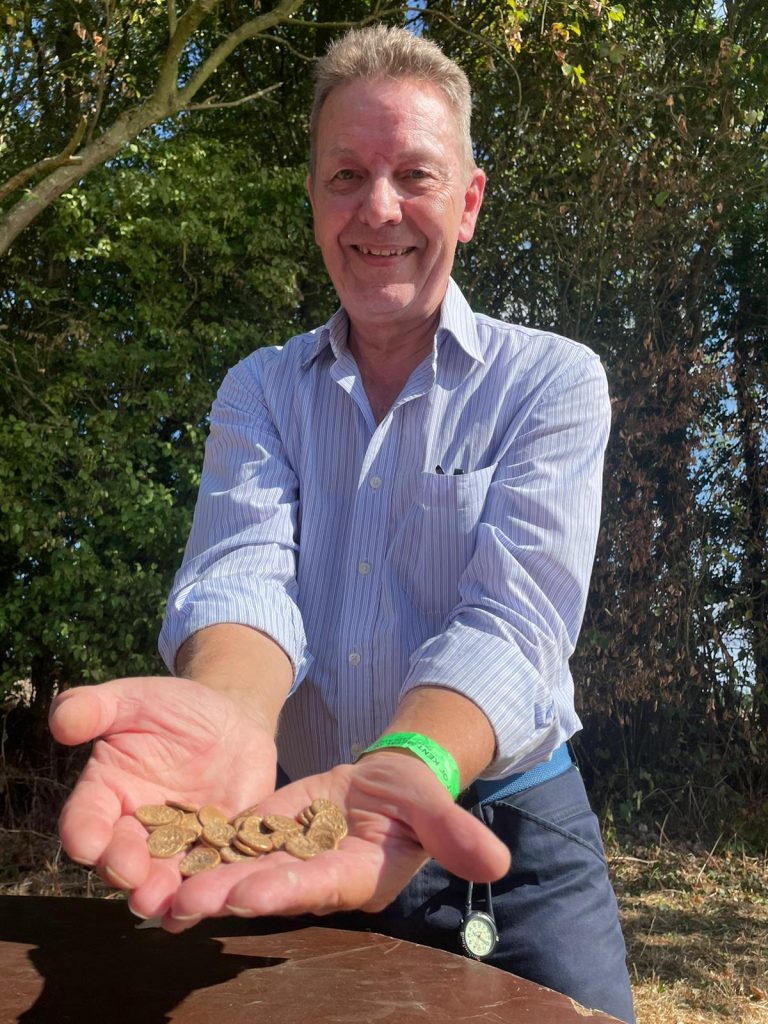
Despite only three hoards of this type being recorded in Kent, their findspots hint at a possible preference for deposition in more marginal areas of landscape away from any potential foci of Iron Age settlement, in a similar manner to the placement of Bronze Age hoards in the area a millennium earlier (see previous blog post about the Lenham Founder’s Hoard Here). The Westerham Hoard was found at the southern end of Hosey common at a high point in the landscape on the watershed of the Darent and Eden Valleys, while the findspot description for the Higham Hoard suggests it was also on higher ground, on the watershed between the Medway and Thames Valleys.
The Lenham Stater Hoard appears to have been placed in the vicinity of a spring and geological mapping of alluvium in the area (British Geological Survey 2022) suggests this formed the source of a minor tributary of the Great Stour to the south. While the Lenham Stater Hoard is on the lower slopes of the valley rather than the high watershed, there is evidence that this part of the landscape may have been historically more marginal. The findspot is located in the vicinity of several blocks of probable ancient woodland, which likely originally formed a larger tract over the area in the early medieval period. The former areas of Lenham Heath and Charing Heath are also located a short distance to the south and south-east of the findspot.
The presence of both woodland and heathland in the surrounding landscape tends to suggest that the area was probably towards the margins of occupation and agriculture during the Anglo-Saxon and medieval periods (the village of Lenham is 2km to the west) and this may also have been the case during the Late Iron Age and Roman periods. It was noted during the event that Iron Age and Roman finds were relatively limited from the surrounding fields. It is possible, then, that the Lenham Stater Hoard may have been deposited within the vicinity of a historic spring in an area that was on the margins of occupation in the Late Iron Age, and this would correlate with the landscape contexts of the Higham and Westerham hoards, which also appear to have been deposited in historically marginal areas of landscape on the watersheds between different river systems.
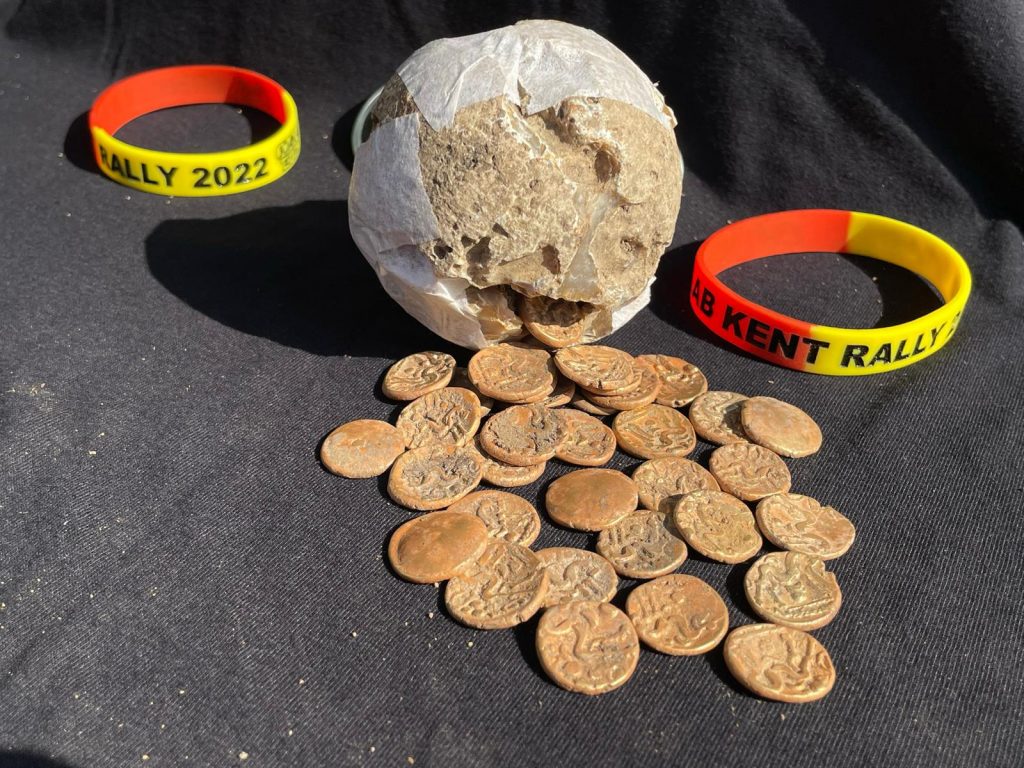
What Next?
At the time of writing, the hoard is currently in the care of the Kent Finds Liaison Officer, where it is awaiting a coroner’s inquest to determine whether this hoard is classed as Treasure. Should it be decided that the hoard is Treasure, the opportunity is then given for local museums to express an inquest in acquiring the hoard. If a museum wishes to acquire the hoard, a valuation process begins where a value for the find is ultimately recommended by the Treasure Valuation Committee at the British Museum and once agreed, this reward is paid out to the relevant parties.
It is hoped that if a museum does wish to acquire this hoard it will be put on permanent public display as a significant and interesting find that contributes to better understanding Iron Age activity in the region.
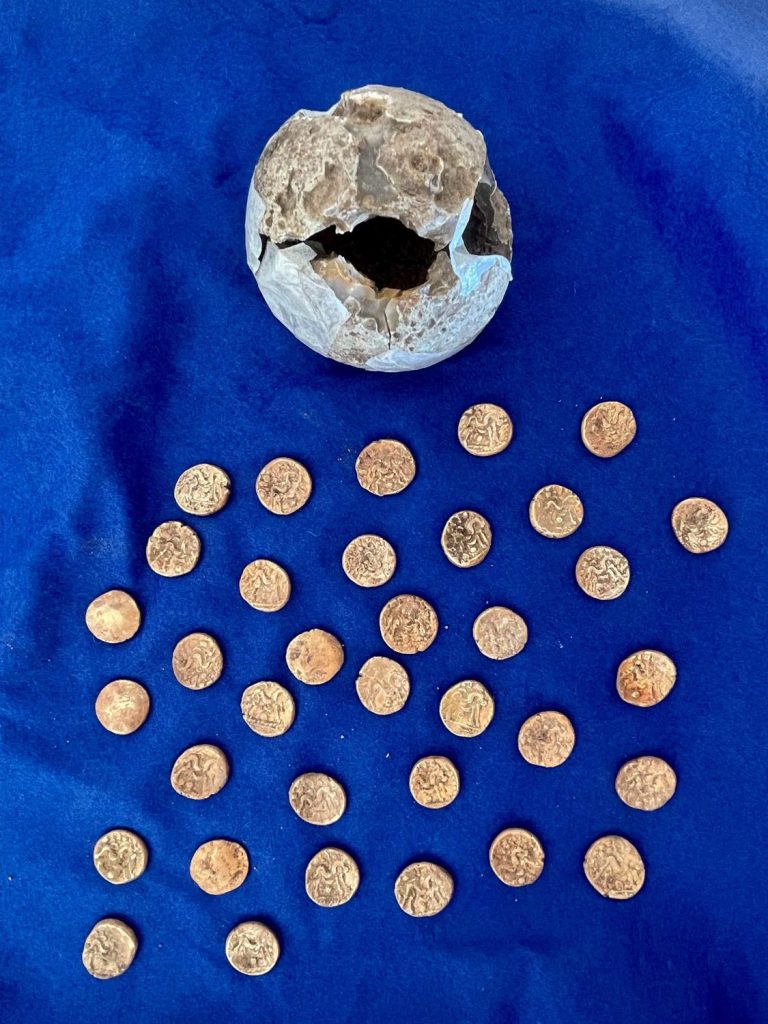
Citations
Printed Works:
Blanchet. A (1950) Proces-verbal de la séance du 7 janvier 1950. Bulletin de la Société française de Numismatique 5, 3-4.
Bland, R. A. Chadwick, E. Ghey, C. Haselgrove, D. J. Mattingley, A. Rogers and J. Taylor (2020). Iron Age and Roman Coin Hoards in Britain. Oxford, Oxbow Books.
Brooke, G. C. (1923) The Numismatic Chronicle and Journal of the Royal Numismatic Society. Fifth Series, Vol. 3, No 3: p. 156.
Brooke, G. C. (1927) The Numismatic Chronicle and Journal of the Royal Numismatic Society. Fifth Series, Vol. 7, No. 28: pp. 370-377.
Cottam, E., P. De Jersey, C. Rudd and J. Sills (2010) Ancient British Coins. Aylsham, Chris Rudd. De
Jersey, P. (2014) Coin Hoards in Iron Age Britain. British Numismatic Society Special Publication 12. London, Spink & Son Ltd.
Websites:
British Geological Survey (2022). Geology Viewer. Website https://geologyviewer.bgs.ac.uk/. Accessed 1st September 2022.

